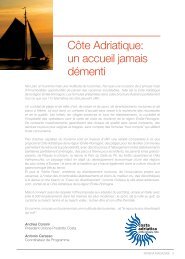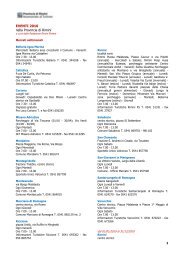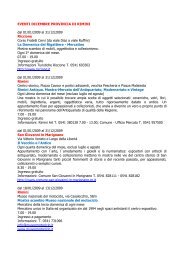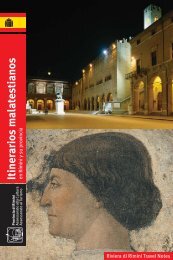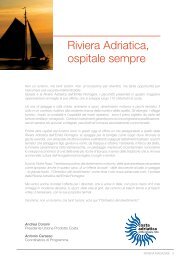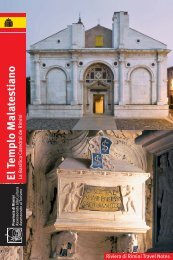Malatesta fortresses and castles
Malatesta fortresses and castles
Malatesta fortresses and castles
- No tags were found...
You also want an ePaper? Increase the reach of your titles
YUMPU automatically turns print PDFs into web optimized ePapers that Google loves.
Above: view of Gemmano.Below: view of Morciano.29two well-fortified villages on the left of the river which (together withGemmano) were partially destroyed during the Second World War.In Montescudo, notice the imposing walls of the castle: huge<strong>and</strong> steeply sloping, they made attack practically impossible. On thesouth tower can still be seen a marble plaque with a high-soundingLatin inscription, engraved with the usual attention to the form <strong>and</strong>arrangement of the letters. Sigismondo declares here that he hasbuilt the great castle from the foundations, to serve as a “scudo”,that is to say, a shield, for the town of Rimini. The year: 1460.Montescudo, dominating as it did all the middle Conca valley <strong>and</strong> thevalley of the Marano brook, exactly facing the enemy fortifications ofSan Marino, was truly the keystone of the entire <strong>Malatesta</strong> defencesystem <strong>and</strong> a vital shield for the defence of the city of Rimini, towhich it was connected by a good road along the crest of the hill,barely twenty kilometres long, with no special defences.On March 31 st 1954, restoration work on the east walls ofMontescudo brought to light twenty-two medals bearing the effigyof Sigismondo. These are some of the famous <strong>and</strong> truly magnificentbronze medals cast by Matteo de’ Pasti in the mid-fifteenthcentury. Others have been found elsewhere, always in the walls of<strong>Malatesta</strong> constructions; we know that the Lord of Rimini used tohave them concealed in the walls so that the memory of his name<strong>and</strong> his face would be sure to survive the destruction of what hehad built, just as the memory <strong>and</strong> the effigy of the ancient Romanemperors survived, through their coins, the destruction of eventheir greatest building works. Naturally, such forethought wasincomprehensible to ordinary people, who invented all kinds of fairytales to explain these finds, interpreting them as treasure troves.Various legends concerning treasure hidden in the walls of<strong>Malatesta</strong> <strong>castles</strong> were current even in Sigismondo’s lifetime; <strong>and</strong>in Montescudo they still day-dream about it.The opposite side of the valley is mostly dominated byGemmano, where the fortifications have been destroyed, <strong>and</strong> byMontefiore (see below), both of which are easily reached fromMorciano. Also leading from Morciano is the road for Saludecio,which crosses the ridge where st<strong>and</strong> Mondaino <strong>and</strong> Montegridolfo<strong>and</strong> then descends to the Foglia valley, most of which is in theregion of Le Marche.Here once more is a border region of huge strategicsignificance, <strong>and</strong> consequently well fortified. Saludecio was alwayspart of the <strong>Malatesta</strong> circuit, although it had its own domicelli, oroverlords, the Ondidei family, murdered in 1344 by a rival family,






